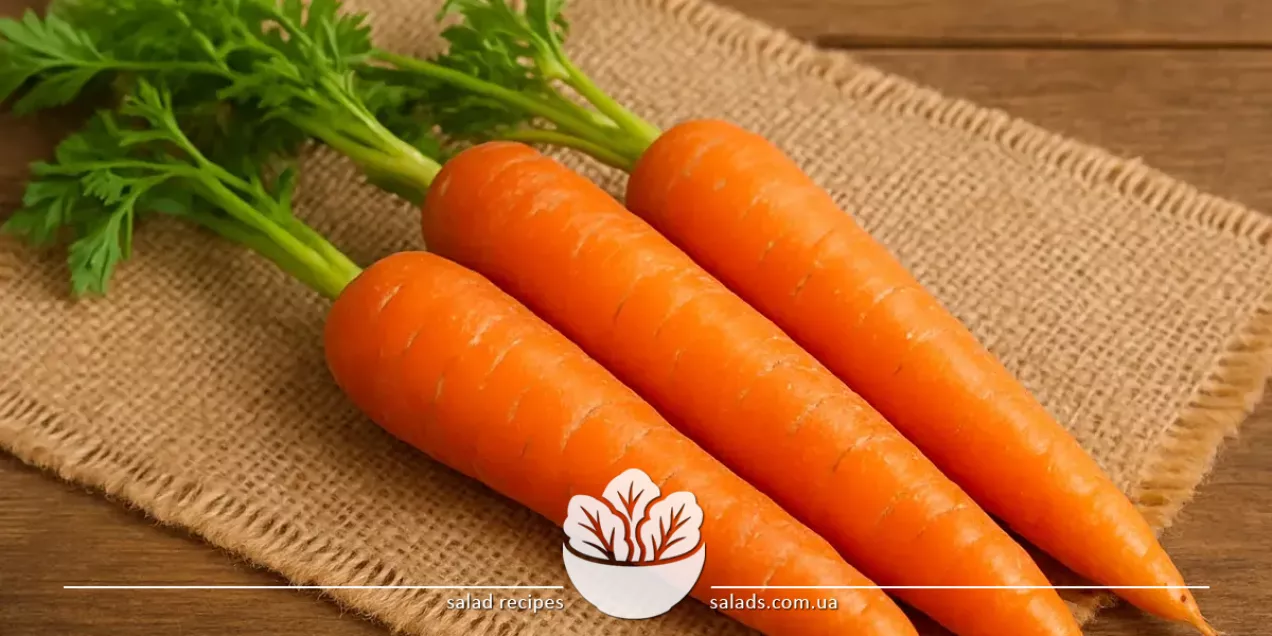
Carrot

Carrot is a root vegetable with a pleasant sweetish flavor and broad culinary potential. It is one of the most commonly used vegetables in daily meals: served raw in salads, boiled for soups, stewed, fried, or baked either on its own or in combination with other ingredients. Carrot pairs well with grains, eggs, meat, fish, other vegetables, and various sauces. In the root vegetables section, you can find other types of vegetables that are useful for creating new recipe variations.
Carrot Salad Recipes
Carrot Salads: Freshness, Crunch, and Vibrancy
Carrot is a core ingredient in many salads, both raw and cooked. It is used grated, julienned, diced, or sliced, often serving as the base or an enhancing component. Fresh carrot adds crunch, lightness, and color, while cooked carrot provides softness and a sweet undertone. Popular options include raw carrot salad with garlic and mayonnaise, Korean-style spiced carrot with vinegar, and salads with mayonnaise or yogurt dressing where carrot is paired with egg, cheese, apple, or nuts. Cooked carrot is a key ingredient in classic multi-ingredient salads such as Olivier or vinaigrette, where it complements other vegetables harmoniously. For instance, in vinaigrette, carrot creates a vivid flavor contrast with sauerkraut, beetroot, potatoes, and pickles, balancing sweet, sour, and salty notes. When combined with fresh herbs, nuts, spices, or seeds, carrot becomes a refined component even in the simplest salad. It enhances the visual appeal and enriches the overall texture of the dish.
Carrot in Soups: A Fragrant Base for First Courses
Carrot is one of the key ingredients in most soups due to its mild flavor, pleasant texture, and ability to add natural sweetness. It is used in vegetable, meat, fish, mushroom, and grain-based soups, and also serves as a base for sautés and broths. Carrot is added chopped or grated, and sometimes sautéed to a golden hue along with onions or tomatoes. In borscht, pickle soup, cabbage soup, and fish soups, carrot provides depth of flavor and color. In baby food and dietary meals, it is often used boiled or puréed – for instance, in cream soups with milk, cream, or vegetable broth. Carrot also pairs well with grains like rice, pearl barley, millet, and buckwheat, making dishes more nourishing and colorful. In modern soup recipes, carrot is combined with ginger, curry, or coconut milk to create vibrant cream soups with an exotic touch. In combination with garlic and herbs, it forms an excellent base for aromatic, light first courses. Carrot not only enhances the flavor – it gives structure, enriches the color palette, and creates a more harmonious soup.
Carrot in Hot Dishes: Stewed, Baked, Fried
In hot dishes, carrot plays an important role as a main or supporting ingredient. It is added to stews, pilafs, sautés, casseroles, vegetable or meat gravies, and oven-baked dishes. When stewed or fried, carrot develops a richer flavor – becoming soft, sweetish, and slightly caramelized. This makes it a great foundation for aromatic combinations with other vegetables, meat, grains, or spices. In classic recipes, carrot is often paired with potatoes, onions, cabbage, or meat products. For example, in stewed vegetables, it adds color and natural sweetness, while in pilafs or stuffed vegetables it helps shape the flavor base. When mixed with cream or sour cream, grated or finely chopped carrot works well in delicate casseroles. A typical example is a vegetable stew with carrot, potatoes, fresh cucumber, and herbs – a light, flavorful, and colorful everyday meal. Carrot handles heat treatment well, retaining its shape and taste, which is why it’s used in dishes of various complexity – from simple sides to complete main courses.
Carrot in Appetizers and Rolls: Bright Ideas for Holidays and Everyday
Carrot is often used in appetizers due to its vibrant color, pleasant taste, and versatility. It is featured in rolls, pâtés, canapés, appetizer salads, stuffed eggs, vegetable spreads, and dips. It pairs especially well with garlic, nuts, creamy cheeses, mayonnaise, or yogurt, creating both bold and delicate flavors. One of the most popular options is a carrot, cheese, garlic, and mayonnaise spread served on toast, in tartlets, or as a filling for rolls. Carrot is also used in Korean-style appetizers with vinegar, sugar, and spices. In vegetarian dishes, it is grated and mixed with seeds, herbs, citrus juice, or hummus. Thanks to its bright color and tender texture, carrot is suitable for both casual and festive dishes. An example is a lavash roll with carrot, chicken egg, cream cheese, and herbs – a quick-to-make dish that looks impressive and tastes fresh. Combined with hard cheese, garlic, or nuts, carrot provides a balanced flavor and pleasant texture. It can be served cold or slightly warmed, either on its own or as part of an assorted platter.
Carrot with Meat, Fish, and Grains: A Versatile Companion
Carrot is an ideal ingredient for creating balanced meals with meat, fish, or grains. Its natural sweetness and delicate texture help balance the more intense flavors of proteins and cereals. It is used in dishes with braised meat, roasts, cutlets, steamed fish, steaks, or boiled grains – both as a side and as part of the main dish. In braised meat dishes, carrot serves not only as an aromatic base but also as a source of moisture and natural sweetness. In pilafs, barley, or millet dishes, it adds brightness, and when paired with meat – it rounds out the flavor. Carrot is also often added to roasts with chicken, veal, or turkey, as well as to fish in cream or tomato sauce. For example, when combined with salted herring, carrot is part of salads and appetizers where it softens the fish’s saltiness. Together with rice, herbs, butter, or soy sauce, it forms a complete dish without meat. Carrot is an exceptionally flexible ingredient that pairs well with core foods and complements both simple and complex recipes.


